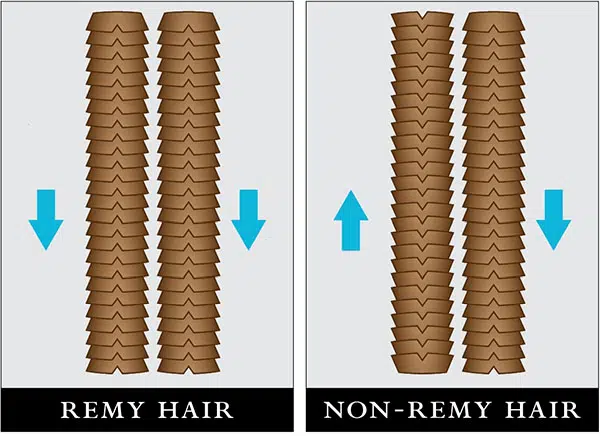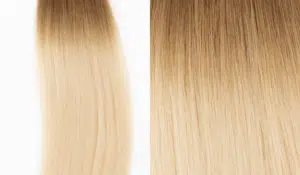Struggling to decode hair terms before a bulk buy or install? You are not alone. The wrong choice can mean tangles, returns, and lost clients.
Remy hair has cuticles aligned in one direction and lasts longer; Non-Remy has mixed or removed cuticles, looks good at first, but wears faster and tangles more. This guide explains what that means for quality, cost, and results.

Choosing well starts with clear definitions. I will keep the language simple, focus on real-world performance, and share factory-grade checks that you can use before you stock or install.
what does remy mean in hair extensions?
You want a definition that works at the chair and in the warehouse. Remy means cuticles point the same way.
Remy hair keeps cuticles aligned from root to tip. This reduces friction, so it tangles less and looks smoother for longer. It costs more because single-direction sourcing is slow and careful.

What it really means in production and behind the chair
Definition
- Remy hair comes from ponytails cut directly from a donor.
- The bundle keeps root and tip orientation, so all cuticles face one direction.
- This preserves the natural scale layer that protects the fiber.
Pros and cons of Remy hair
- Pros: smoother feel, less matting, better color hold, less dryness over time, higher client satisfaction, longer service life.
- Cons: higher raw-hair cost, limited super-long lengths, supply constraints, price sensitive for first-time buyers.
Performance notes from a factory view
Remy input controls everything downstream. Because cuticles remain, we do not rely on heavy acid baths or thick silicone to hide defects. The hair stays responsive to moisture and behaves like healthy human hair. This also means finish work (color and texture) looks more natural. On the cost side, sourcing aligned ponytails takes time. Long lengths are rare because hair grows slowly. Each extra inch represents months of growth. This scarcity drives price, but it also drives consistency and fewer returns. In salons, less detangling time and fewer re-dos save labor. This is why many premium brands use Remy for core lines. When you see a true one-direction bundle, the baseline quality is built in. If a vendor uses “Remy” only as a marketing word but still removes cuticles chemically, you lose these benefits. The term must link to sourcing, not just to a smooth surface finish.
What is non-Remy hair?
You need a clear picture. Non-Remy means mixed directions or missing cuticles.
Non-Remy hair is often collected from salon floors and brushes. Cuticles point different ways. Vendors may strip or soften cuticles with acid and then coat the hair in silicone for shine.
Why it looks fine on day one but not month three

Definition
- Collected from multiple sources with no root–tip control.
- Cuticles are misaligned or removed to prevent instant tangling.
- Silicone makes the surface feel smooth at first touch.
Pros and cons of Non-Remy hair
- Pros: lower price, easy entry for seasonal or short-term styles, fast availability, broad color range.
- Cons: coating wears off, tangles increase, dryness rises, color fades faster, shorter service life.
What processing does to fiber behavior
To make Non-Remy usable, many factories remove or soften cuticles with an acid bath and add silicone for slip and shine. The hair leaves the box looking glossy. After a few washes, the coating thins. The fiber then shows its true state: more friction, more knots, and less moisture retention. For budget-focused clients or one-off looks, this still can work. For daily wear, active lifestyles, or heat styling, the gap vs Remy grows. If a brand is transparent that its baseline line is Non-Remy and priced for short wear, the value can fit. Problems start when Non-Remy gets labeled as Remy in marketing. That mismatch hurts stylists and suppliers because returns spike. Clear labeling and realistic wear guidance prevent frustration.
what is the difference between remy and non remy hair
The real gap is in cuticle direction, processing load, and service life.
Remy keeps aligned cuticles and needs less chemical masking. Non-Remy corrects misalignment with acid and silicone, then declines faster as coatings wash off.
Side-by-side for buyers and stylists
Core technical contrast
| Attribute | Remy | Non-Remy |
|---|---|---|
| Sourcing | Single-direction ponytails | Mixed sources (floor/brush) |
| Cuticles | Intact, same direction | Mixed or removed |
| Processing load | Lower; light finishing | Higher; acid bath + silicone |
| First-wash feel | Soft and natural | Very smooth (coating) |
| After 4–8 washes | Still smooth, less frizz | Drier, tangles increase |
| Color holding | Better | Fades/brasses faster |
| Typical lifespan* | 6–12 months | 1–3 months |
*With proper care and professional installation.
What this means in daily use
With Remy, brushing is easier. Heat styling is more predictable. Water from hard-water regions is still a risk, but Remy tolerates minerals better because the cuticle layer is intact. Non-Remy can be fine for a special event or a low-commitment look. For long wears, Remy reduces maintenance tickets and protects your schedule. For wholesalers, Remy lowers return rates and preserves brand reputation. When you plan a tiered line, place Non-Remy as an entry option with honest wear windows, and keep Remy as the mainline.

Is non-Remy hair better than Remy hair?
It depends on the job. For short, budget looks, Non-Remy can be “better” value. For long wear and repeat clients, Remy wins.
Use client intent and budget to decide. Map the wear window, styling habits, and water quality.
Fit-by-use framework
When Non-Remy can be the right tool
- One-event installs and quick transformations.
- Photo shoots, stage looks, or trial colors.
- Clients who change styles monthly and accept a short lifespan.
- Low-risk testing of new textures or shades.
When Remy is the better investment
- Daily wear, heat styling, and long commutes.
- Clients who want fewer salon visits for detangling.
- Brand lines that promise luxury feel and longevity.
- Install methods that depend on fiber strength (hand-tied wefts, keratin tips, refined tape tabs).
Business math
A cheaper first invoice can cost more after replacements and reputational damage. If your brand promise is premium, Non-Remy will fight that promise. If your brand serves seasonal trends fast, Non-Remy can fill that lane well. Set expectations in writing. Label wear-time windows clearly. Keep a maintenance sheet for each tier.

Is Remy hair worth the extra cost?
For long wear and client loyalty, yes. The higher raw-hair price pays back in fewer problems.
Remy cuts detangling time, reduces aftercare complaints, and keeps color true longer—key drivers of repeat business.
Cost–value breakdown you can explain to clients
Where the cost comes from
- Single-donor ponytail sourcing is slow and scarce.
- Long lengths reflect months or years of growth.
- Ethical collection and traceability raise raw cost.
Where the value shows up
- Smoother daily finish without heavy serums.
- Better response to toner and gloss services.
- Longer refit cycles with less fiber loss.
- Lower returns and higher five-star reviews.

Talking points at consultation
Show a small strand test: wet the strand, pinch at the midshaft, and slide fingers toward the root. True Remy feels smooth both ways but slightly more drag root-to-tip. Coated Non-Remy feels slippery until the coating thins. Emphasize total cost of ownership, not just the first invoice. Clients understand shoes and handbags; the same logic applies to hair.
How can you tell if hair is truly remy?
Do not rely on the label. Use simple checks before you stock or install.
Check cuticle direction, water behavior, and how the hair ages through washes.
Practical verification checklist (factory to salon)
Quick physical checks
- Direction test: align a small bundle. Stroke root→tip and tip→root. Natural resistance should be slightly higher tip→root if cuticles are present and aligned.
- Backcomb-in-water test: submerge, then gently backcomb. Remy resists locking; Non-Remy snarls faster.
- Light test: under bright light, Remy shows fine cuticle sheen; heavy silicone looks glassy.
Wash-down check (very important)
- Wash 3–5 times with a gentle sulfate-free shampoo.
- Track slip loss. If the bundle turns rough quickly, coating was doing the work.
- Note color stability. Cheap acid-treated hair often brass or dulls fast.
Documentation and supplier transparency
- Ask for sourcing notes: ponytail collection, region, and donor handling.
- Ask if there was an acid bath or heavy silicone coating.
- Request a small pre-shipment sample from every batch.
- Keep a sample book with dates and wash counts for QA.

My opinion
From a manufacturing view, true Remy starts at the source. If the ponytail is aligned and stays that way through sorting, everything else gets easier—color, texture, and wear. Non-Remy has a place for fast looks and tight budgets, but it should be labeled clearly with honest wear windows. For salon mainlines and premium brands, Remy supports your promise. It protects time, protects reviews, and protects margins. If you must carry both, separate them by name, packaging, and care sheets. Do not mix lines. Clarity builds trust.
FAQ
Is “Remy” the same as “virgin”?
No. Virgin means never chemically processed for color or texture. Remy describes cuticle alignment. You can have Remy colored hair, and you can have non-Remy virgin hair.
How long does Remy hair last with proper care?
On average 4–8 months, depending on install method, water quality, and heat styling. Some clients get longer with gentle care.
How long does Non-Remy hair last?
Usually 1–3 months. Silicone wear-off, mineral buildup, and heat speed up decline.
Does hard water change the outcome?
Yes. Minerals stick to rough or exposed fibers faster. Remy tolerates it better, but both types benefit from chelating shampoo and shower filters.
Are there signs Non-Remy was mislabeled as Remy?
If the hair feels amazing on day one but turns dry and tangly after 3–5 washes, coating did the work. Ask for batch samples and do wash-down tests.
Which install methods pair best with Remy?
Hand-tied wefts, genius wefts, high-grade tape, and keratin tips all benefit from Remy due to fiber strength and predictable behavior.
Conclusion
Remy aligns cuticles and delivers longer, smoother wear; Non-Remy trades price for shorter life. Match each type to the client’s budget, wear window, and brand promise for the best results.
Hibiscus Hair Manufacturer has been dedicated to producing high-quality hair extensions for 25 years and is a recognized leader in the industry. If you are interested in finding a reliable hair extensions supplier and wholesale for your brand, please visit our website for more information:
QUALITY





